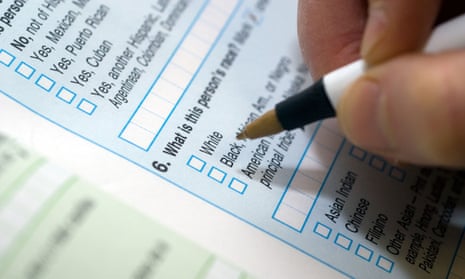We live in a weird time for whiteness. But, before I get into that, a small disclaimer. You may look at my name and worry that I am unqualified to speak about whiteness; I would like to set these doubts to rest and assure you that I myself am a white person. It’s true that, technically speaking, I’m a bit brown but, when it comes to my legal standing, I’m all white. Well, I’m white in America anyway. The US Census Bureau, you see, defines “white” as “a person having origins in any of the original peoples of Europe, the Middle East, or North Africa”. Being half-Palestinian and half-English I fall squarely into that box.
But I may not be able to hang out in that box much longer. There are plans afoot to add a new “Middle East/North Africa” category to the US census. After 70-plus years of having to tick “white” or “other” on administrative documents, people originating from the Middle East and North Africa may soon have their own category.
Whether our very own check box is a privilege or petrifying is still to be decided. Middle Easterners aren’t exactly persona particularly grata in the US right now. Identifying ourselves more explicitly to the government might not be the smartest move – particularly considering that, during the second world war, the US government used census data to send more than 100,000 Japanese Americans to internment camps.
All of this is a little odd. Why are people from the Middle East counted as white by the US government but considered definitely-not-white by many Americans? How can you count somebody as white one year and then decide they’re not white the next year? Indeed it raises the question, what actually is “whiteness” and who qualifies as white?
Once upon a time this wasn’t a question that was asked very much in western countries. White people were the majority and white was simply the default. Demographics have changed, however, and, over the past decade, census data on either side of the Atlantic has been warning white Brits and Americans that they may soon become a minority. This has thrown whiteness into crisis and has had a not-insignificant part to play in Brexit, the election of Trump, and the rise of a new wave of white nationalism. The so-called alt-right, for example, was born out of the idea that white identity is under attack. As Dan Cassino, a political scientist, told the Guardian: “The founding myth of the alt-right is that the disadvantaged groups in American politics are actually running things … [and] oppressing white men.”
The idea that white identity is under attack assumes that whiteness is something fixed, something immutable. But whiteness has always been a fluid category. Whiteness isn’t a biological fact, rather it is a sort of members-only club that has rewritten its entry requirements over the years.
Take the Irish, for example. Today, Americans love the Irish and celebrate St Patrick’s Day enthusiastically. (And by celebrate I mean they get very drunk in the middle of the day – a practice Americans call “daydrinking” and Brits call “an ordinary weekend”.) However, when the Irish first came to the US in large numbers nobody was holding parades in their honour; rather they were vilified in the same way that Mexicans and Muslims in the US are vilified today. In How the Irish Became White (1995), Noel Ignatiev writes that “While the white skin made the Irish eligible for membership in the white race, it did not guarantee their admission; they had to earn it.” Ignatiev, along with others, argues that the Irish earned their admission by embracing racism against African-Americans; reinforcing their whiteness by emphasising other people’s blackness. Ignatiev quotes John Finch, an Englishman who travelled the US in 1843, saying: “It is a curious fact that … the poorer class of Irish immigrants in America, are greater enemies to the Negro population … than any portion of the population in the free States.”
It’s not just the Irish who have worked their way into whiteness over the years. Italian-Americans have been similarly whitewashed. And in How Jews Became White Folks and What That Says About Race in America (1998), Karen Brodkin argues that Jewish intellectuals helped to “whiten” US Jews during the 1950s and 1960s. Jews, she says, are now considered white – but perhaps not for ever. Whiteness doesn’t just expand to let people in, it can also contract and spit people out. In an essay last year, Brodkin wonders whether Trump will “unwhiten” Jews.
Whiteness has a slightly different shade of meaning in the UK than it does in the US but Brits are grappling with similar classification problems. What, for example, is to be made of Polish people, who have now overtaken Indians to become the largest foreign-born group in the UK? They may be considered white in Poland but in Britain both the census and popular sentiment classifies them as “white other”, as distinct from “white British”.
Ultimately, what really defines whiteness is not melanin or nationality – it’s power. And while demographics may be shifting, Kenneth Prewitt, a former director of the United States Census Bureau, is sceptical that whites will ever be a minority. White people will “figure out some way to reshuffle the deck”, he told me, finding new ways to bolster their numbers and protect white privilege. Perhaps, in the near future, he suggests, successful Asians (now classed as “honorary whites”) will undergo a similar process to the Irish and become “white.” When you look at the mutable history of whiteness the idea is certainly not beyond the pale.

